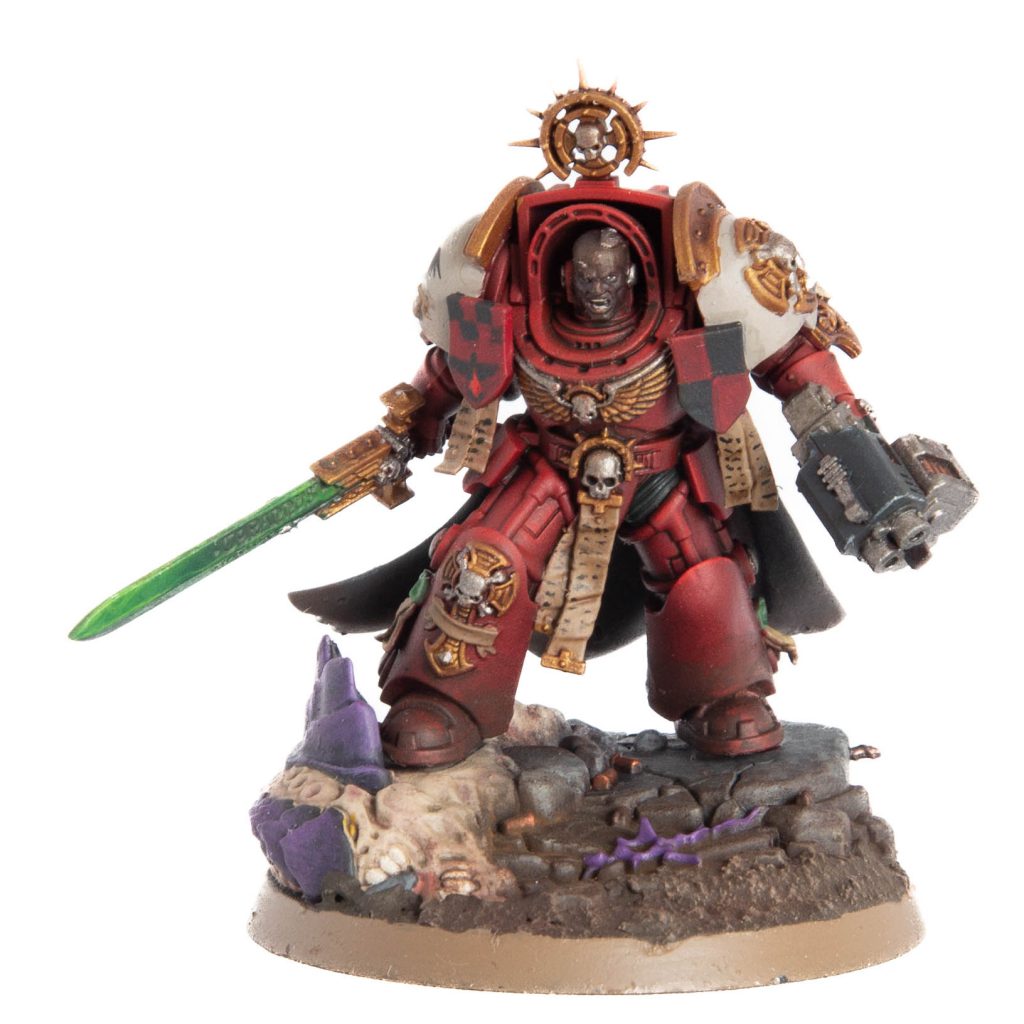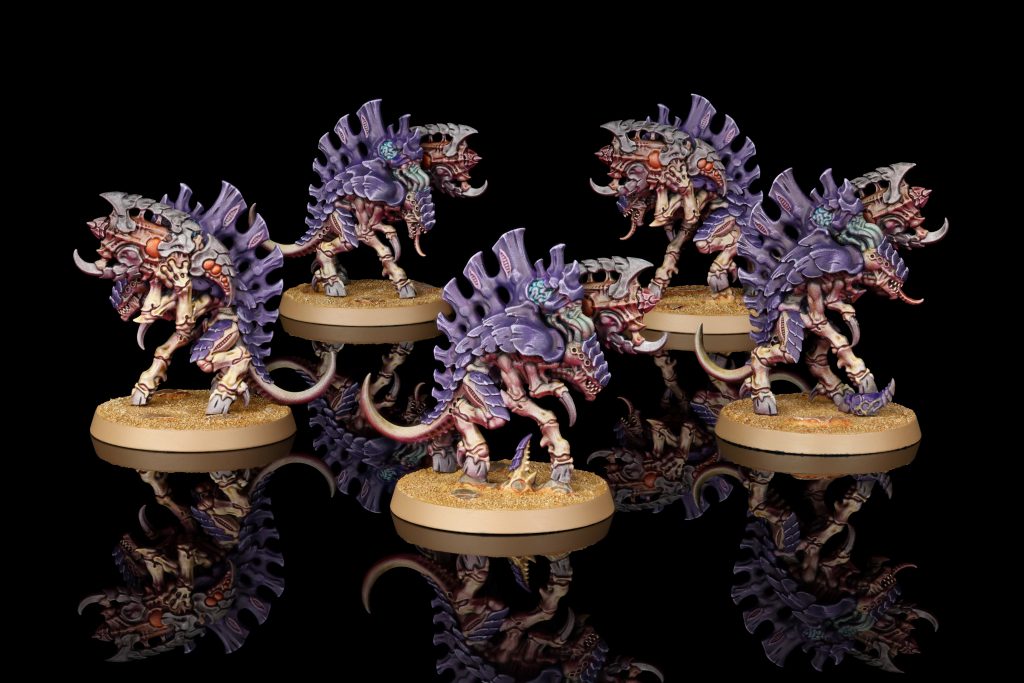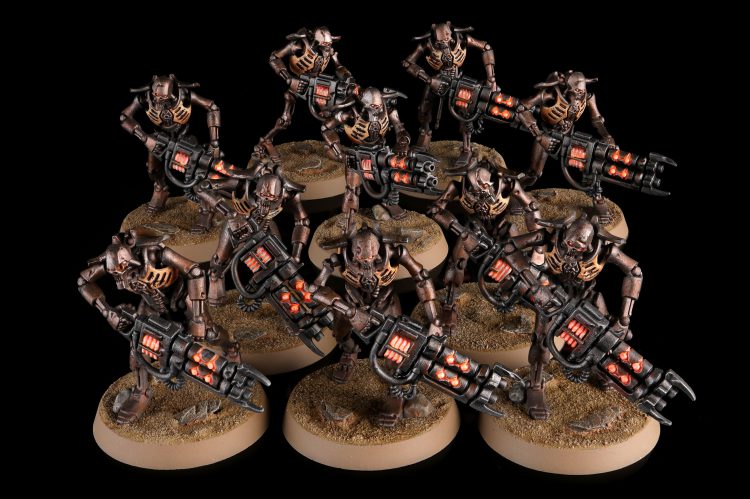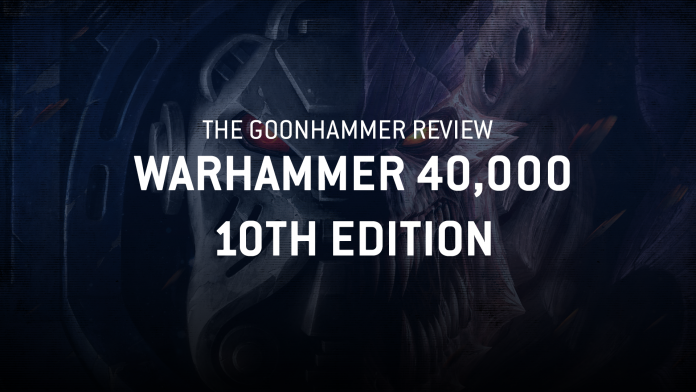We’ve talked a lot over the past two weeks about what to expect from the new edition of 40k, but there’s an entirely new game mode that’ll be releasing together with the Leviathan box set that’s worth discussing: Combat Patrol. This streamlined mode of play serves as a replacement for the 500-point games in previous editions, and aims to provide a fun and balanced way to play smaller and quicker games with a minimum of pre-game setup. But is it worth your time to check out? Read on to find out.
Once again, thanks to Games Workshop for providing us with a preview copy of these rules.

So what is Combat Patrol?
Combat Patrol is a new game mode that serves as Games Workshop’s answer to a common issue with low point-value games: all too frequently, the rules don’t feel like they “scale down” well to 500-point games, often incentivizing imbalanced “skew” lists that can result in serious feels-bad moments at the table.
Their previous outing at solving this problem, Boarding Actions, attacked it with two solutions: first, it significantly limited the number of units, enhancements, and stratagems that can be used in the game mode, cutting down not only on the sheer number of interactions that needed to be considered in these smaller games, but also removing certain categories of them wholesale. Second, the terrain and mission design breaks up the board significantly, limiting players’ ability to have multiple units attack the same target without potentially giving up board position and adding additional rules to make things work with smaller armies.
Combat Patrol ditches Boarding Actions’ second solution wholesale and goes all-in on the first, limiting players even further to specific pre-built lists with fixed loadouts, limited enhancement and stratagem choices, and a secondary designed around your particular Combat Patrol. As an added bonus, these lists are built using the contents of precisely one (1) Combat Patrol box for your chosen faction, making it easy for a new player (or someone new to a particular army) to get all the models needed to play your first game, even at a discount over buying them separately.

At the end of the day, this means that there’s effectively no list-building that goes into a game of Combat Patrol, and very limited customization: you have a single enhancement for your Warlord that you can swap out for one other if you’d prefer, and some larger units come with the “Patrol Squads” rule, letting them deploy either as their full complement or split up into smaller units to help play the board better. As one example, the Space Wolves Combat Patrol comes with 10 Incursors, but you can instead choose to deploy them as two squads of 5 each.
The limited options here have several implications for the game. First, and perhaps most obviously, any time you run into a particular faction in this mode, the opposing force is going to be nearly identical from a gameplay perspective. This is helpful for knowing what to expect when you go into the game, but does mean that the variety of lists you’ll run into is drastically restricted. Perhaps more importantly, though, by limiting what can be brought into a game, the designers have ensured there are fewer outliers that you’ll have to worry about, meaning that you’re less likely to run into something completely game-breaking.
Combat Patrol Datasheets
But the limited number of datasheets isn’t the only change: in addition to limiting which units and weapons you can bring, Combat Patrol also trims down the number of unit abilities you’ll have to deal with during a game. As just one example, Captain Octavius, the Terminator Captain from the Leviathan box set, not only comes with a fixed loadout of storm bolter and relic weapon, but he loses the index Captain’s Rites of Battle ability. Similarly, the Redemptor Dreadnought in the Dark Angels Combat Patrol loses its Duty Eternal ability, while Archon Malivex in the Drukhari box has no datasheet abilities whatsoever.
This is unquestionably a drop in effectiveness for a lot of these units. But the abilities that are lost appear to generally fall into one of two categories. First, there’s stuff like Duty Eternal. At toughness 10 with 12 wounds and a 2+ armor save, the Redemptor is already a tough unit to deal with for most of the stuff it’s going to run into, and while every Combat Patrol here has something that can credibly damage it, none of them are particularly heavy on anti-tank. Adding damage reduction to the mix could have very easily made this unit game-warping in a way that was untenable, so I’m glad they decided to leave it out.

The other category here includes things like Space Marine Captains’ Rites of Battle or the Drukhari Archon’s Devious Mastermind: this shit is just more complicated than necessary here, particularly for a game mode that’s intended to serve as a new player’s first game. Removing some of these more complex abilities makes it easier for a new player to get to grips with the basics of how the game plays while minimizing the time spent staring at datasheet abilities making sure they’re not losing out on some minor bit of additional effectiveness.
At the end of the day, the result of all of these restrictions is likely a net positive, especially since this mode is targeted at newer players, or someone looking for a quicker game without having to put in a ton of effort at list-building. If you want the customization of a full game of “real” 40k, 1000-point Incursion games are right there. But as an “onboarding” tool for fresh faces or a way for experienced players to potentially squeeze in a game of 40k over a long lunch break, this streamlined mode of play is definitely worth checking out.
The Missions
In addition to the fixed army lists, Combat Patrol also offers a set of six missions with fixed deployments, primary objectives, and a bespoke mission rule. Some of these are very simple: the first mission on offer, Clash of Patrols, is Dawn of War deployment with a straightforward 5VP for each objective you control at the end of your Command Phase. As a bonus, during your Command Phase, you can choose an objective you control and gain a bonus CP, so long as your Warlord is on the board and nobody’s chosen that objective yet. It’s a neat little rule that provides some additional incentive to take control of the board while also affording you an extra CP or two over the course of the game to use on various stratagems.
Later missions get a little more complicated, introducing concepts that you’ll see in some of the Leviathan mission pack cards. Forward Outpost sees players setting up four objectives, with one in each deployment zone and two in No Man’s Land, but you can’t score off the one in your own DZ. You don’t want to leave it entirely undefended, though, as if your opponent manages to hold it at the end of your turn, you’ll lose the ability to use the Command Re-roll stratagem for the rest of the game.

Scorched Earth, on the other hand, is a four-objective mission that offers 5 points for controlling one or more objectives, and another 5 for holding more than your opponent does. In addition to introducing this common method of scoring the primary objective, if there are two or more objectives left on the board, you can choose one of them you control (so long as it’s not the one closest to your DZ, anyway) and remove it from the board, scoring yourself a nifty 10 point bonus and limiting the options for scoring on future turns.
All in all, the missions here are solid, if somewhat straightforward. There’s nothing here that approaches the sheer complexity of some of the more involved crusade missions we’ve seen, and none of the objectives are as involved as the more elaborate ones in the Leviathan mission pack (I’m looking at you, Deploy Servo-Skulls). That being said, there is a nice variety of missions on offer here, and they’re straightforward enough for newer players to pick up without being so simple that returning players will be bored to tears. And having the missions be fixed sets of deployment map, primary, and mission rule takes another step out of setup, which gets you into the game that much quicker.
Final Thoughts
It’s clear that Combat Patrol was deliberately written with intent to drastically streamline the process of preparing for and playing a game. By distilling down the process of building your list, choosing your mission, and playing the game to about as few rules as are possible to have while still remaining recognizable as 10th-edition 40k, they’ve managed to deliver an experience that is not only significantly more approachable for new players from a rules perspective, but also just a lot faster to set up and play once you get to the table.
So is it for everyone? That’s a simple question with a more complicated answer. If you’re an experienced player with the time and the models to hand to play an Incursion or Strike Force game, then chances are you’ll get more out of just playing a larger game. And there’s nothing wrong with that. Depending on what factions you collect and what models you have for them, you may find it difficult to field the appropriate Combat Patrol without having to make some wargear substitutions, or fielding that one unit whose paintjob you find yourself wishing you’d redone every time remember you own it. And even if you’ve got what you need for the Combat Patrol, you might just prefer playing a game where you have access to all of the myriad options available to your faction.

But if you’re looking to get a game in and only have about an hour and a half to play, chances are you can get through a Combat Patrol game in that limited time, something that can’t be said for anything 1000 points and up. By stripping out the more complicated interactions and boiling the game down to its core, Combat Patrol leaves us with a game that’s dead simple to set up and lightning-fast to play – at least by 40k’s standards, anyway. And the smaller board size makes it playable on nearly any dining-room table, even ones that can’t fit the 60”x44” Incursion and Strike Force board.
These same strengths make it perfect for teaching new players the game. The core concepts that you’ll have to learn in order to succeed here translate flawlessly to larger games once you’ve finished enough models to field a 1000-point Incursion army (though many of the specific faction rules have changed, and sometimes in unusual ways). And by the time you’ve played a few games of Combat Patrol and really internalized the basics, you’ll be ready to build on that foundation with the addition of Detachment Rules, more stratagems, and the wider selection of units on offer with their various datasheet abilities. And all of this is set against the backdrop of a fixed $160 USD/95 GBP initial investment that gives you every model you need to play your first game. I’d honestly be hard-pressed to think of a better format to teach someone how to play 40k.
At the end of the day, Combat Patrol isn’t going to replace Incursion or Strike Force games for me. If given the option and provided with adequate time, I’d honestly probably prefer to play the larger game using all of my favorite units rather than being limited to a fixed selection of units for every game. But I don’t always have the time to play a full 2000-point game of 40k, and it’s not unusual for me to find myself wishing for a way to squeeze in a game when I don’t necessarily want to spend the next 2-3 hours standing around the table.

And that’s where Combat Patrol really shines: the dream of playing a game of 40k over your lunch break may finally be within reach. You could even credibly set up and play a Combat Patrol game at a board game night and still have time to jump in on the party game that the rest of the group falls into when they run out of ideas of what else to play later in the evening. And if you or someone you know has been thinking about getting into 40k but wasn’t sure where to get started, now there’s an easy solution: for $160 and the time it takes to put the models together, you can have everything you need to play 10th edition 40k.
Combat Patrol games offer something new: a way to play a quick game that’s reasonably balanced with as little setup as possible, and we’re excited to play more of them. They won’t always be the game you’re looking to play at any given moment, but when you want something a little more streamlined that plays significantly faster, look no further.
Have any questions or feedback? Drop us a note in the comments below or email us at contact@goonhammer.com. And make sure to check back later this week for our impressions of the various factions’ Combat Patrols and how they’ll play on the table.


